Course:FNH200/2011w Team21 Banana

Introduction
Banana is a tropical fruit commonly produced in Central America or anywhere else in an environment that is hot and humid. Bananas typically takes nine months to grow. Many different types of bananas are exported and imported all over the world . These include but not limited to the following: yellow, small, sweeter dark brown, maroon banana and plantain . [1] Currently, bananas are grown in over 107 countries. The top producers are India, China, Philippines, Brazil, Ecuador and Indonesia. Approximately 73 million metric tons of bananas are produced each year all over the world. [2] Some bananas can be consumed right after you peel the skin and other bananas may require some cooking before consuming. [1]
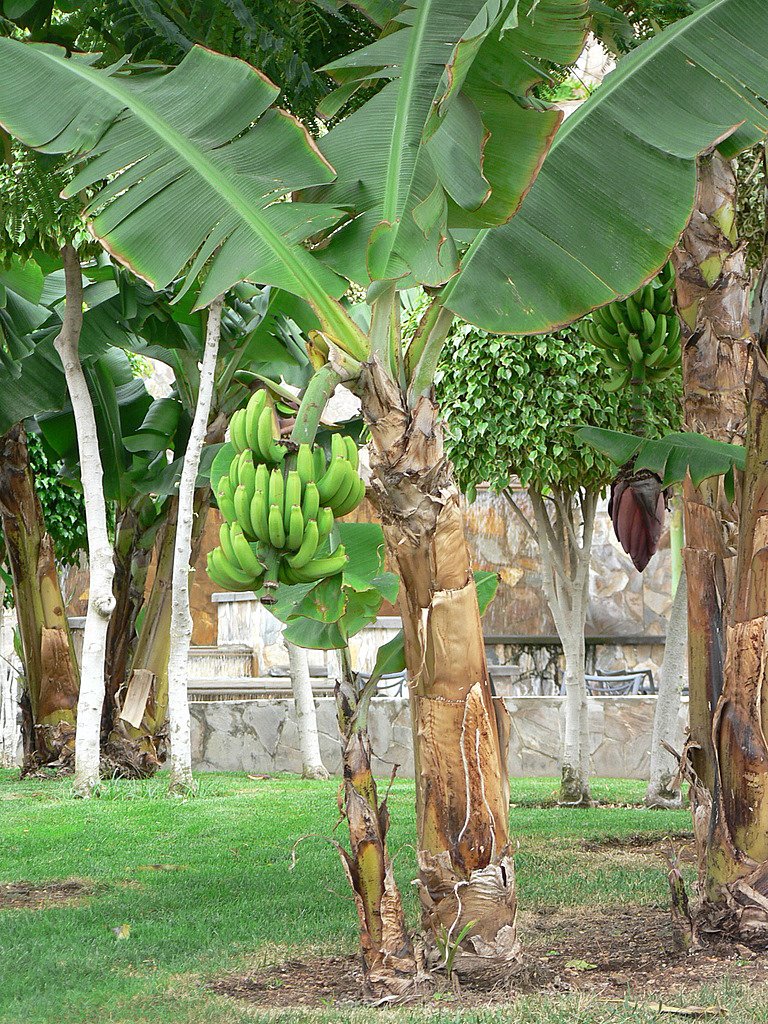
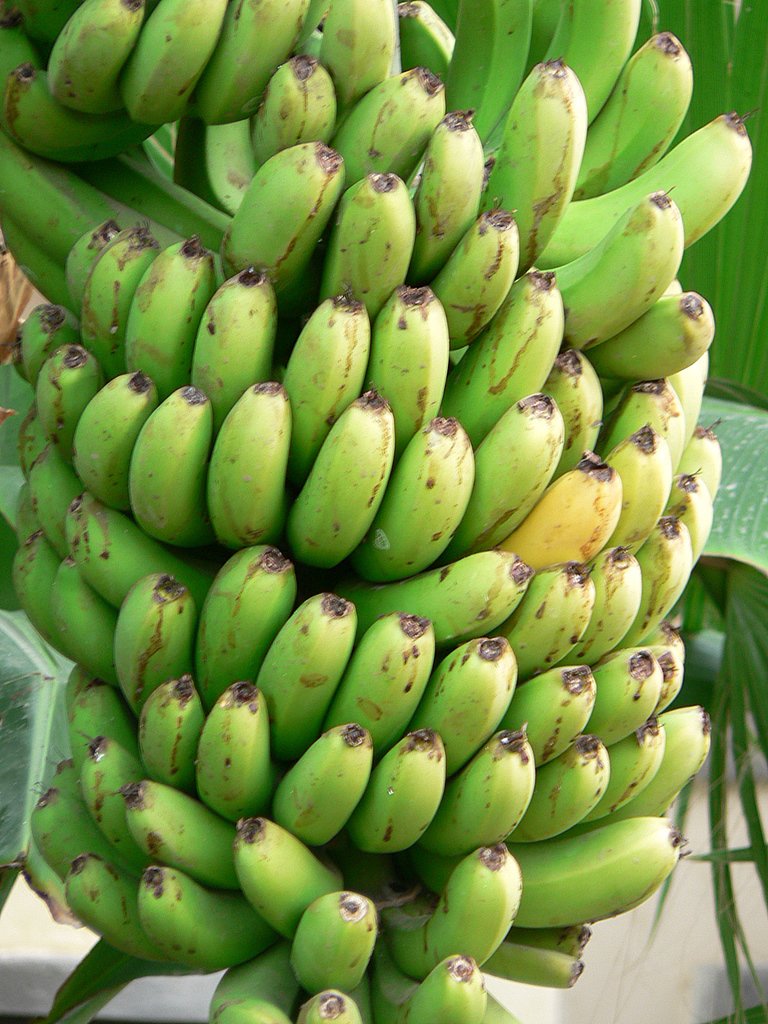
Banana Processing
Plantation
Bananas are normally grown on a large scale. Therefore a large land mass is needed to include all the processing equipment and storage facilities. Depending on the retail stores, farm markets and consumers demands for bananas all over the world, bananas are harvested at different times during their development. Furthermore, if the bananas are exported, they need to be harvested early in their growth cycle. Usually harvesting earlier means the bananas are very green. By harvesting earlier, it will allow the bananas to ripen during the journey to other countries. Hence, when the customers purchase the banana from the retail store, it will be instantly or near ready to consume. [1] When the bananas are ready to harvest, the farmer will cut the banana stalk from the tree. Normally one stalk consists roughly 20 to 25 bananas. Once the stalk has been chopped and collected into a truck, the stalks are transported to the banana processing plant. [1]
Processing Plant
The processing plant can be either very complex or very simple. However, the routine is almost the same for each banana processing plants. The banana plant is an open-air sheltered building where there are equipments, workers, and produce interactions. Each stalk is removed from the truck and hanged up on a cable like a pulley system that goes above the workers head. The stalks are transported by the pulley system to a ground level barrel filled with flowing water. The flowing water is made up of diluted chemicals to help remove insects. Along the side of the barrel, workers cut the banana from the stalk and the banana falls into the barrel. Since the water is flowing, the bananas are transferred in the direction of another group of workers that distinguishes the good banana from the rotten ones. Finally, the good bananas are collected by hand from the barrel and then placed onto a table. Since the bananas are still wet, they are dried on its own or by some portable fans. When the banana is entirely died, they are placed in cardboard boxes. Each box can hold up to approximately 40 pounds of bananas. Finally once the boxes are packaged they are ready to be shipped to the distribution centers for exporting, local retail markets, or they are shipped to other plants for extra processing. [1]
Shipping
After the boxes leave the processing plant, the boxes are transported either by trains or trucks to the distribution centers or other locations. The boxes are contained in an energy intensive refrigeration unit. The low temperature can prevent the banana from ripening too quickly. When the importing country receives the boxed bananas, they place the boxes in a warehouse that helps to artificially ripen the banana using ethylene and gradually increasing the temperature in the warehouse. When the boxes are transferred from the warehouse to the retailers and wholesalers. They supply the bananas to the smaller shops and markets; a vehicle usually transports this. [3]
Toxicants and Foodborne Disease
Foodborne diseases associated with the consumption of raw fruits have generally been rare in the past. In recent years however, as consumers change their diet and increase consumption of raw fruit, the frequency of outbreaks caused by contaminated raw fruit has also increased [4]. In addition, factors such as the quality of water used in irrigation and increased susceptibility of the population to foodborne diseases have contributed to an increased frequency of diseases associated with fruits. In bananas, the most common source of microorganisms would be from the peel. A banana could be contaminated from the soil, manure or fecal matter from animals, irrigation water or rainfall. However, since banana peels are removed prior to consumption, the edible portion of the banana usually poses no risk to the consumer [4]. Although bananas do not contain any natural constituents that are toxicants, there may be traces of environmental toxicants from the use of pesticides. In a study conducted by Sudha and Kumaravel [5], samples of banana fruit were found to contain levels of carbendazim, a widely used fungicide, that exceed the limits set by the FAO/WHO Codex Alimentarius. They concluded that the health of consumers could be adversely affected by the misuse of pesticides in the long run. Other pesticide residues commonly found on bananas include thiabendazole and imazalil, both of which are probable carcinogens and can have adverse effects on human development or reproductive systems [6].
Preservation and Dehydration
Preservation by Low Temperature
Preservation is necessary for varieties of foods, and bananas is one of the essential products that should have specific preserving method in order to maintain its quality and prevent ripening. Freezing and drying bananas are a few methods of preserving bananas. Another method immersing the peeled ripe bananas in salt water for three minutes, then treated with disinfectants and then with a fixing agent, fix the natural colour of the banana. [7]. Afterwards, the bananas are cover in cloth and put into greenhouse with temperature of 80-100°F for about 10 days. [7] Also, once the bananas are grown, they are plucked one month before they become completely ripe. The main goal of preservation of bananas is to prevent producing their natural ripening agent, ethylene.[8] Bananas are kept at temperatures ranging from 13.5°C to 15°C during transportation in order to minimize ripening. It is known that bananas show a colour change in the peel from yellow to black when it is stored below temperature of 13°C. [9]
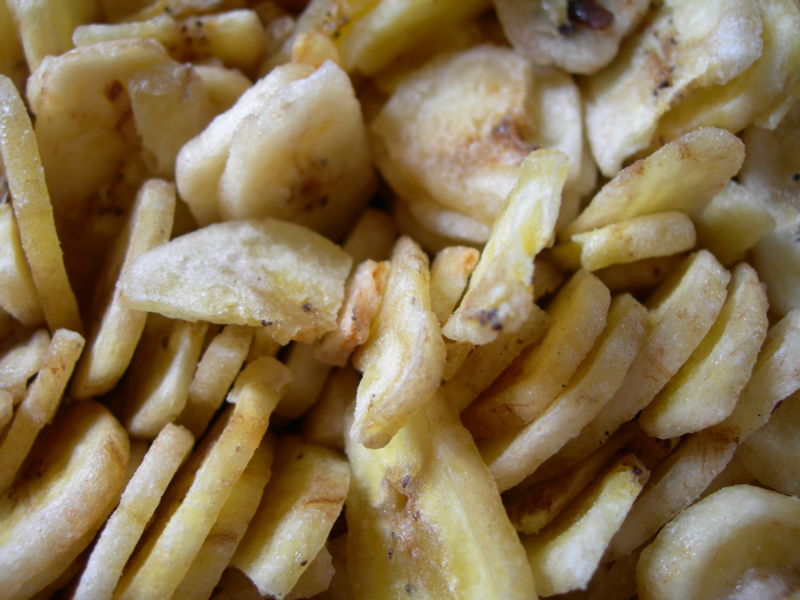
Dehydration of Bananas
Out of several methods of dehydration that exists, conventional hot air drying has been used commonly for drying bananas[10]. Conventional hot air drying is a method where air temperature, air velocity, air humidity and the slice thickness determine the quality of the dried bananas. [11] The higher the temperature of air, the more moisture it holds before becoming saturated. [12] With air velocity, faster velocity will dry the product more rapidly. [12] Moreover, air that is more humid absorbs more moisture before becoming saturated. As with the surface area, it is faster to remove moisture with smaller products. [12] Bananas that have been dried this method are usually difficult to rehydrate as it has been shrunken and also very is dense.[12] In addition to the appropriate conditions, bananas are also immersed into potassium metabisulfite or citric acid solution. [11] Compared to bananas which were not immersed into either of these solutions, these soaked bananas improved the quality of the bananas by reducing darkening of bananas during drying. [11] For bananas, it was determined that air temperature of 60°, air velocity of 1ms-1 and humidity of 10g kg-1 were the suitable values in order to obtain good quality of dried products. [11]
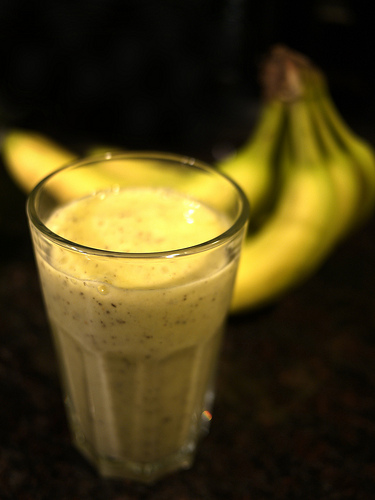
Thermal Processing
The most common thermally processed banana product is banana puree. Uses of banana puree include baby food, bakery, and confectionery uses. Before a banana is pureed, the whole fruit is heated to at least 80°C for 3 minutes. This process inactivates the polyphenol oxidase enzyme which causes the fruit to brown [13]. After being thermally processed, the puree is aseptically packaged to ensure commercial sterility. Some purees are acidified to a pH range of 4.3 – 4.5 [14], which effectively inhibits growth of microorganisms.
Irradiation
Food irradiation is a method of food preservation. Radiation can cause food irradiation in form of ionized energy. Electromagnetic radiation with an isotope of cobalt 60 is used in Atomic Energy of Canada Limited (AECL) as an energy source in development of food irradiation. Irradiation is only approved in four food categories in Canada. Fruits and vegetables are not approved in Canada but they are approved in the United States. [15]
According to Anthony Watts, we don’t live in a radiation free world. Radiation is everywhere, as he showed his neighbor a device called Geiger counter that measured ionizing radiation. He showed his neighbor that cosmic rays were whooshing right through her.[16] From an article from Wikipedia “Banana equivalent dose” I came to know that bananas have an unusual units of radiation exposure that will be absorbed from eating one banana. Bananas contain radioactive isotopes even in the absence of any artificial pollution or contamination. Our body is fairy constant in absorbing and eliminating due to homeostasis. Therefore our body is exposed to radiation due to eating a banana for only few hours after ingestion. That is mainly because our body takes time for its normal potassium content to be restored by the kidneys. This is a normal procedure that takes in our body throughout life. Potassium generates radiation, constantly throughout our lifetime. [17] According to David Merrefield in “Irradiation must be explained to consumers to succeed” explains that’s irradiation is safe and beneficial as it delays ripening and extend shelf life. [18]
The effects of gamma radiation on the self-life of bananas were studied to see how the self-life of bananas could be extended. They saw that bananas self-life was extend by 20 days and there was no taste change. In the nutritional aspect, there was a minor decrease in ascorbic acid, but other than that there was no other change in its nutritional and chemical content. [19]
Regulations
All bananas in Canada are imported from either Asia or South America. With that in mind, all fresh food imports must meet certain requirements from the Canadian Food Inspection Agency before entering into Canada. First, all importing companies must be licensed with the Canadian Food Inspection Agency. Second, shipment of the fresh food must be in a standard container; in the case of fresh food, shipment must not be marketed in containers exceeding 50 kilograms. Third, a Confirmation of Sales Form must be completed at the time of shipment’s entry. Lastly, the product must comply and meet all the health and safety requirements of Fresh Fruit and Vegetable Regulations and the Food And Drug Regulations. [20]
Labelling
When displaying bananas in a retail store, the bananas must either be unlabelled, except for barcodes, number codes, environmental statements, and product treatment symbol, or without any packaging. If the bananas are being packaged, the packaging must be in a clear transparent protective wrapping. [21]
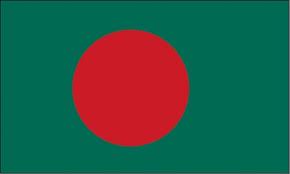
Trends in Food for Nutrition and Health
Bananas are considered to be a tropical fruit, which is available throughout the year in warmer countries such as Bangladesh. Bangladesh produces 42% of total production of bananas. If you compare nutritional values of apples to banana, you will see that bananas have five times more vitamin A and iron than apples, four times more protein, three times more phosphorus, and twice the carbohydrates and other vitamins and minerals. [19]
Interesting Facts
- Ripe bananas are yellow, but they also come in purple and red.
- People with a latex allergy may also be allergic to bananas.
- Bananas are very healthy and contain good levels of vitamin B6, vitamin C, and potassium.
- Original wild bananas contained large seeds. [2]
High oxygen is the main reason of peel spotting in banana
Here we want to disscuss the effect of high oxygen on early peel spotting . The banana at first will change its color to yellow and green, then will held in containers with a continuous gas flow of oxygen. High oxygen is the main factor of peel spotting. It is concluded that peel spotting was not correlated with in vitro PAL and PPO activities. Decrease in dopamine levels correlated with peel spotting, depicting that it might be used as a substrate for the browning reaction. Influence of ripeness and air temperature on changes in banana texture during drying.
The effect of ripeness and air temperature on changes in banana texture throughout drying
The degree of ripeness of fresh banana highly affects the rheological qualities of the dried product, changes in fresh banana were first of all occurred during storage at room temperature and humidity. This research made it possible to find out the limiting factors which discern difference between degrees of fruit ripeness––moisture content, sugar content in the pulp, inflexibility of the banana. The changes in rheological properties were observed by penetrometry throughout the drying test. This experiment illustrated that the radical change in the rheological behavior of the slices depends on the fruit ripeness after 4, 6 or 8 h of drying at 80 °C: they lost their deformability and became delicate. An analysis of the thermo-mechanical qualities of the slices by dynamic mechanical thermal analysis demonstrated that this sudden change in the properties must be connected to the product going below the glass transition temperature (Tg) as it is cooled after drying.
Starch digestibility and glycemic content of cookies alternated with unripe banana flour
The Mexican government noticed that their most of their population has health problems and they struggle with obesity. Because of this problem the development of nutraceutical foods with a low glycemic index is significant. Cookies with unripe banana flour (UBF) are essential to avoid fat and digestible carbohydrates maintain in body. Moisture and dietary fiber content will become greater than before, but protein and fat will become lesser when the UBF level increased in the cookie. A parallel outline was found for available and resistant starch. Resistant starch substance is crucial because of the appearance associated with its fermentation in the colon. When the quantity of UBF was enlarging in the cookies, the rapidly digestible starch diminished and the digestible starch improve. To attain a product with high level of indigestible carbohydrates, simple formulation for cookie preparation is central.
References
- ↑ 1.0 1.1 1.2 1.3 1.4 Essortment, 2011. Banana Plant: Processing From Tree to Box. http://www.essortment.com/banana-plant-processing-tree-box-54085.html. Last accessed 15 March 2012.
- ↑ 2.0 2.1 Want to Know It, 2012. Where Do Banana come from. http://wanttoknowit.com/where-do-bananas-come-from/. Last accessed 15 March, 2012.
- ↑ Harmer E., 2008. The Banana Brief. http://www.theecologist.org/green_green_living/food_and_drink/269413/the_banana_brief.html. Last accessed 15 March 2012.
- ↑ 4.0 4.1 Beuchat, L., 1998. Surface decontamination of fruits and vegetables eaten raw: a review. World Health Organization. http://www.who.int/foodsafety/publications/fs_management/en/surface_decon.pdf. Last accessed 14 March 2012.
- ↑ Sudha, P. and Kumaravel, S., 2012. Determination of Pesticide Residues in Banana by Using High Performance Liquid Chromatography and Gas Chromatography-Mass Spectrometry. American Journal of Biochemistry and Biotechnology 8(1), 1-6.
- ↑ Punzi, J., Lamont, M., Haynes, D., Epstein, R., US Department of Agriculture, 2005. USDA Pesticide Data Program: Pesticide Residues on Fresh and Processed Fruit and Vegetables, Grains, Meats, Milk, and Drinking Water. http://www.ams.usda.gov/AMSv1.0/getfile?dDocName=STELDEV3003674. Last accessed 14 March 2012.
- ↑ 7.0 7.1 Delgado, Camen. et al., 1968. Process for preserving Bananas. United States Patent Office.
- ↑ “Banana”. Wikipedia: The Free Encyclopedia. Wikimedia Foundation, Inc. 20 March 2012. Last assessed 20 March 2012.
- ↑ Chan, J., 2012. “FNH Lesson 7”. http://wiki.ubc.ca/Course:FNH200/Lesson_07. Last accessed 20 March 2012
- ↑ Pan, Z, Shih, C, McHugh, Tara H, and Hirschberg, E. “Studying of banana dehydration using sequential infrared radiation heating and freeze-drying” LWT. Food Science and Technology. Vol.41 Issue.10 (2008): 1944-1951.
- ↑ 11.0 11.1 11.2 11.3 Argyropoulos D, Montoya J M C, Maurer C, Müller J. “Convective hot-air drying of banana in Uganda” Centre for Agriculture in the Tropics and Subtropics. (2009) 6.-8.10.2009
- ↑ 12.0 12.1 12.2 12.3 Chan, J., 2012. FNH Lesson 8. http://wiki.ubc.ca/Course:FNH200/Lesson_08. Last accessed 20 March 2012.
- ↑ Food and Agriculture Organization of the United Nations (FAO), 2002. Principles and practices of small- and medium-scale fruit juice processing. http://www.fao.org/docrep/005/y2515e/y2515e17.htm. Last accessed 14 March 2012.
- ↑ Chiquita Fruit Ingredients, 2007. Chiquita Acidified Banana Puree. http://www.chiquitapfi.com/cfi/assets/productspecs/banana/1600%20banana%20acidified%20puree%205gal%20bib%20-%2020.9kg.pdf. Last accessed 14 March 2012.
- ↑ Chan, J., 2012. FNH Lesson 10. http://wiki.ubc.ca/Course:FNH200/Lesson_10. Last accessed 20 March 2012.
- ↑ Watts A, 2011. Going bananas over radiation. http://wattsupwiththat.com/2011/02/16/going-bananas-over-radiation/. Last accessed 20 March 2012.
- ↑ Banana equivalent dose. http://en.wikipedia.org/wiki/Banana_equivalent_dose#Radiation_from_other_foods. Last accessed 20 March 2012.
- ↑ Merrefield D., 2007. Irradiation Must Be Explained to Consumers to Succeed. http://webcache.googleusercontent.com/search?q=cache:AKAaY2GQ9ZkJ:supermarketnews.com/blog/irradiation-must-be-explained-consumers-succeed+irradiation+of+bananas&cd=3&hl=en&ct=clnk&gl=ca&client=safari. Last accessed 20 March 2012.
- ↑ 19.0 19.1 Zaman, W., Paul, D., Alam, K., Hassan, P., 2007. Shelf Life Extension Of Banana (Musa Sapientum) by Gamma Radiation. Journal of Bio-Science. 15, 47-53.
- ↑ Canadian Food Inspection Agency, 2012. http://www.inspection.gc.ca/english/fssa/frefra/cdnreqe.shtml. Last accessed 19 March 2012
- ↑ Department of Justice, 2012. http://laws-lois.justice.gc.ca/eng/regulations/C.R.C.,_c._285/index.html. Last accessed 19 March 2012
22.Journal of Food Engineering, Volume 55, Issue 2, November 2002, Pages 115-121 N. Boudhrioua, C. Michon, G. Cuvelier, C. Bonazzi
23.LWT - Food Science and Technology, Volume 46, Issue 1, April 2012, Pages 177-182 Edith Agama-Acevedo, José J. Islas-Hernández, Glenda Pacheco-Vargas, Perla Osorio-Díaz, Luis Arturo Bello-Pérez
24.Postharvest Biology and Technology, Volume 43, Issue 1, January 2007, Pages 128-132 Thararat Maneenuam, Saichol Ketsa, Wouter G. van Doorn